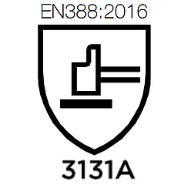| What Is EN 388?26 March 2020 Work gloves that are classed as PPE must uphold to a number of internationally recognised standards before they are sold. This improves the standards of the gloves available, but also improves the level of safety on offer, meaning that you can get to work, or buy gloves for your staff, without worrying as much about safety. What Standards Am I Looking For?There are a long list of standards that you can expect a pair of gloves to be certified too. These include:
The list is long, however those four cover the main standards in the PPE Safety Glove industry. The standard that we're concerned about today is EN 388 - Protective Gloves Against Mechanical Risks. EN 388 ExplainedWhat Is EN 388?EN 388 measures how will a glove will protect you against mechanical risks. These are Abrasion, Cut, Tears, Punctures and occasionally Impact. How Does EN 388 Work?Every single time a glove is produced, it will be tested against abrasion, tears, punctures and a straight blade cut. Occasionally, a glove will also be tested against a circular blade and impact. This isn't always the case, but if you want to know why please click here. How Do I Know If a Glove Passed EN 388?You can find the results from EN 388 (or any EN standard) in one of four places. These are:
What Results Can A Glove Receive?A glove can achieve the following results (the higher the better)*:
*If a glove fails any of these tests it will receive a Level 0. If a glove isn't tested to one of these tests you will see either an N/A or an X. Each Test In DepthAbrasion ResistanceThis test is performed by rubbing abrasion paper against the gloves until a hole is appeared. Scores can be seen below:
Cut Resistance (Circular Blade)A rotating blade is pressed against the palm of the glove, and the number of cycles that result in a cut are recorded.
*Please note that this test has been succeeded by a straight cut test. It is less common that this result will be on the back of the gloves and will often be marked by an "X". Tear ResistanceFour patches from the gloves are placed within the jaws of a machine. These are gently pulled apart until a rip appears.
Puncture ResistanceAs above, samples are taken from a glove and a compression machine will push a stylus into the gloves. The results are measured by the force required to cause a puncture.
Cut Resistance (Straight Blade)The newer cut resistance standard draws a blade across the material until a cut appears. Pressure is gently increased, and a score is awarded depending on when the glove is cut.
What Am I Looking For in the Product Listing?Every single one of our gloves that has been tested to EN 388 will demonstrate their results in the product listing. Below you can see what you can typically expect to see in our listings: EN 388
In the gloves above, you can see that they perform well with abrasion and tears, however you probably wouldn't want to use them for protecting against punctures. As is becoming common practise, these gloves have not been tested to the old cut standard, however have been tested to the newer cut standard where they achieved a Level E. As these gloves achieved a Level E (second highest), they would be ideal for handling very sharp items. Why Are Some Gloves Tested to Two Different Cut Standards?Up to 2016, a glove would be tested to Abrasion, Circular Blade Cut Resistance, Tears and Punctures. In 2016 the standard was updated, and the circular blade test was replaced by the straight blade test. Occasionally, a glove will be tested to both, however this isn't compulsory. A glove has to be tested under the newer straight blade test before production. Are the Two Cut Resistances Linked?This is where the two cut tests get a little confusing. Generally, a Cut C or above under the new test is the equivalent of a Cut 5 under the old test. However, this isn't always the case, so a good rule of thumb is to look at the new test only and remember that they are both completely different tests. Please Click Here to Return to How Does EN 388 Work? Make Sure You Understand EN 388Understanding EN 388 is the key to hand safety. The majority of the gloves above are tested to EN 388, so we encourage you to look into what each gloves receive before making your final choice. For more information on EN 388 or any of our gloves, don't hesitate to get in touch at helpdesk@gloves.co.uk. |







